|
|

HNA Summary Report
Desired
Future Habitat Conditions
|
|
A primary element of the Environmental Management Program Habitat Needs
Assessment was to identify the various natural resource management agencies’
and the publics’ desired future mix of habitats throughout the Upper
Mississippi River System. 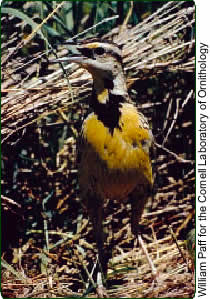 This
effort was pursued through review of recent agency management plans, a
series of meetings with the public, and a series of workshops with river
scientists and natural resource managers. In general, agency management
plans were found to lack specific quantified objectives for specific land
cover or habitat classes. Certain documents such as the recently completed
Partners in Flight Bird Conservation Plans and the Upper Mississippi &
Great Lakes Region Joint Venture Implementation Plan articulate goals
to restore avian populations to specified levels, and contain state-by-state
objectives for habitat management and restoration. Through the resource
manager meetings, we obtained rather uniform qualitative expressions for
future desires, but quantitative estimates of desired future habitat conditions
were more variable depending on the part of the river considered. The
desired future conditions identified in this first Habitat Needs Assessment
can be considered a good first approximation of goals for habitat protection
and restoration for the UMRS. It is likely that future desires, and thus
habitat needs, will be revised as new information is obtained and the
public has an opportunity to provide additional input. This
effort was pursued through review of recent agency management plans, a
series of meetings with the public, and a series of workshops with river
scientists and natural resource managers. In general, agency management
plans were found to lack specific quantified objectives for specific land
cover or habitat classes. Certain documents such as the recently completed
Partners in Flight Bird Conservation Plans and the Upper Mississippi &
Great Lakes Region Joint Venture Implementation Plan articulate goals
to restore avian populations to specified levels, and contain state-by-state
objectives for habitat management and restoration. Through the resource
manager meetings, we obtained rather uniform qualitative expressions for
future desires, but quantitative estimates of desired future habitat conditions
were more variable depending on the part of the river considered. The
desired future conditions identified in this first Habitat Needs Assessment
can be considered a good first approximation of goals for habitat protection
and restoration for the UMRS. It is likely that future desires, and thus
habitat needs, will be revised as new information is obtained and the
public has an opportunity to provide additional input.
|
|
Consultations with Resource Managers and
Scientists
The workshops with resource managers resulted in fairly consistent qualitative
expressions of future desires. In particular, resource managers and scientists
indicated that the future should be characterized by: improved habitat
quality, habitat diversity, and a closer approximation of the pre-development
hydrologic regime. They believe these changes are critical to the sustainable
ecological integrity of the river ecosystem. Deep backwaters, grasslands,
hardwood forests, and marsh habitats were rated the most threatened habitats.
River regulation, sedimentation, and floodplain development were rated
as the primary stressors affecting river habitats.
|
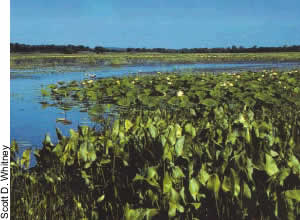 |
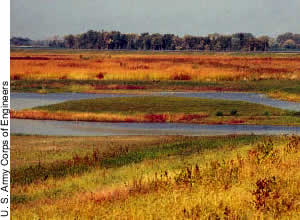 |
|
Deepwater marsh habitat.
|
Floodplain grasslands.
|
|
|
The qualitative assessments revealed which habitats are threatened or
degraded and in need of preservation or restoration at the pool scale.
However, quantitative results from the workshops differed among river
reaches due to differences in the quality and amount of information about
existing and forecast future conditions. In particular, resource managers
found existing data inadequate for an in-depth, uniform, system-wide quantitative
habitat needs assessment. Also, of note is the concern that not all future
habitat changes are detected by using estimates of geomorphic change and
by relying on one-time "snapshots" of habitat conditions.
Despite these limitations, a first approximation of quantitative desired
future habitat was identified and used to calculate habitat needs (see
HNA Technical Report). This information represents the first time system-wide
objectives have been identified for use in planning Habitat Rehabilitation
and Enhancement Projects on the UMRS.
|
|
Public Involvement
In 1996, the Long Term Resource Monitoring Program published the results
of a public expectations survey. While the survey was not designed specifically
for use in the Habitat Needs Assessment (HNA), it revealed that:
- 99% of respondents value the rivers for future generations
- 70% of respondents want to control industrial pollution
- 55% of respondents want improved water quality
- 45% of respondents want improved fish and wildlife habitat
- 25% of respondents want improved sport fishing
- 15% of respondents want less barge traffic
The public involvement meetings, convened in April and May 1999 and used
as input to the HNA, revealed five themes or areas of interest for the
future of the Upper Mississippi River System:
- more fish and wildlife in general
(habitat diversity, species diversity, and abundance),
- clean and abundant water
- reduced sediment and siltation
- balance between the competing uses and users of the river
- restoration of backwaters, side channels, and associated wetlands
|
|
While the five themes were clear, there appeared to be slight regional
variations in how the respondents expressed their views. These differences
may be related to the quality of the habitat in their area or the degree
of access for recreation.
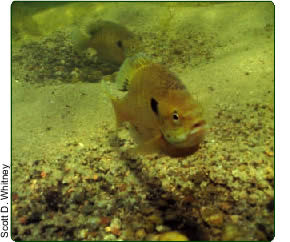 Respondents
cited the assurance of acceptable water quality and quantity for human
consumption, industrial processes, and aquatic habitat conditions as a
priority. Sedimentation was cited as a concern because it jeopardizes
features such as backwater lakes, the navigation channel, recreational
access to various areas, water quality, and riverbed conditions. Among
the habitats of interest, backwater lakes and associated wetlands are
of particular concern as fish spawning and overwintering sites, food sources
during key periods for migratory waterfowl, and critical linkages to both
terrestrial and deeper aquatic environments. In addition to the difficult
and essential task of balancing competing uses that affect resource quality,
it is noteworthy that respondents cited other "social" aspects
of the river: the need for more citizen awareness and initiatives related
to the river and the need to improve government agency coordination for
consistent management and project completion. Respondents
cited the assurance of acceptable water quality and quantity for human
consumption, industrial processes, and aquatic habitat conditions as a
priority. Sedimentation was cited as a concern because it jeopardizes
features such as backwater lakes, the navigation channel, recreational
access to various areas, water quality, and riverbed conditions. Among
the habitats of interest, backwater lakes and associated wetlands are
of particular concern as fish spawning and overwintering sites, food sources
during key periods for migratory waterfowl, and critical linkages to both
terrestrial and deeper aquatic environments. In addition to the difficult
and essential task of balancing competing uses that affect resource quality,
it is noteworthy that respondents cited other "social" aspects
of the river: the need for more citizen awareness and initiatives related
to the river and the need to improve government agency coordination for
consistent management and project completion.
|
|
In July-August 2000, a series of focus groups offered insights into the
public’s view of the HNA process itself. Participants in the focus
groups generally thought the HNA is another useful tool for river resource
management in the UMRS. The concept of using habitat classifications to
frame river management issues was acceptable to the majority of participants;
they were generally comfortable that the specified habitat classes chosen
by the HNA developers were workable and useful. However, participants
wanted more definition of those habitats, and many participants felt that
more factors needed to be considered, such as water quality and the impacts
of dynamic river processes on static habitat classifications. While focus
group participants tended to think of river issues at a local level, the
majority agreed that a broader scale was necessary for planning, at least
at the system if not at the watershed level. Participants also generally
accepted the use of presettlement river system conditions as a reference
point, although concerns were raised about the compatibility of older
data sources and the utility of incorporating in the planning process
a river condition that could never again be replicated. Administrative
aspects of the HNA that participants found particularly important were
further development of the HNA, multiagency cooperation, and continued
public involvement in and access to the HNA. Many participants expressed
confusion about the actual application and end result of the HNA.
|
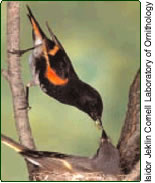
The desired future river conditions participants expressed generally reflected
the five themes from the spring 1999 public meetings. A "multi-use"
river was the most frequently expressed desired condition. Two conflicting,
overarching desired conditions were expressed: a return to more naturally
variable conditions and a stabilization of existing conditions. Other
desirable river conditions expressed included a sustainable, natural river
ecosystem and increased biodiversity. Most participants felt strongly
that a diverse public should be continually involved in river management
programs.
|
|
Unique Habitat Areas
Despite the extensive habitat changes brought about by development
of the navigation system and floodplains, there are many unique
habitat areas in the UMRS that provide examples of presettlement
habitat conditions, are relatively undisturbed, and support high
biodiversity. Unique habitat areas on the UMRS range from channels
with gravel and bedrock substrate, to tributary delta areas, clear
vegetated backwater lakes, mast-bearing (oaks, hickories, pecan)
floodplain forests, cypress swamp forests, and remnant floodplain
prairies. State Natural Heritage inventories have identified most
of the unique habitat areas. Many of the unique habitat areas are
in public ownership and are protected. Some should be expanded to
make the unique habitat areas more complete and buffered from disturbance.
Other unique habitat areas are not publicly owned and are in need
of protection. Some examples of unique UMRS habitat areas include:
- Rush River Delta State Scientific and Natural Area, Mississippi
River Pool 4
- Kellogg-Weaver Dunes State Scientific and Natural Area, Mississippi
River Pool 5
- Reno Bottoms, Mississippi River Pool 9
- Sanganois State Fish and Wildlife Area, Illinois River
- Remnant cypress swamps, Shawnee National Forest, southern Illinois
|
|



 This
effort was pursued through review of recent agency management plans, a
series of meetings with the public, and a series of workshops with river
scientists and natural resource managers. In general, agency management
plans were found to lack specific quantified objectives for specific land
cover or habitat classes. Certain documents such as the recently completed
Partners in Flight Bird Conservation Plans and the Upper Mississippi &
Great Lakes Region Joint Venture Implementation Plan articulate goals
to restore avian populations to specified levels, and contain state-by-state
objectives for habitat management and restoration. Through the resource
manager meetings, we obtained rather uniform qualitative expressions for
future desires, but quantitative estimates of desired future habitat conditions
were more variable depending on the part of the river considered. The
desired future conditions identified in this first Habitat Needs Assessment
can be considered a good first approximation of goals for habitat protection
and restoration for the UMRS. It is likely that future desires, and thus
habitat needs, will be revised as new information is obtained and the
public has an opportunity to provide additional input.
This
effort was pursued through review of recent agency management plans, a
series of meetings with the public, and a series of workshops with river
scientists and natural resource managers. In general, agency management
plans were found to lack specific quantified objectives for specific land
cover or habitat classes. Certain documents such as the recently completed
Partners in Flight Bird Conservation Plans and the Upper Mississippi &
Great Lakes Region Joint Venture Implementation Plan articulate goals
to restore avian populations to specified levels, and contain state-by-state
objectives for habitat management and restoration. Through the resource
manager meetings, we obtained rather uniform qualitative expressions for
future desires, but quantitative estimates of desired future habitat conditions
were more variable depending on the part of the river considered. The
desired future conditions identified in this first Habitat Needs Assessment
can be considered a good first approximation of goals for habitat protection
and restoration for the UMRS. It is likely that future desires, and thus
habitat needs, will be revised as new information is obtained and the
public has an opportunity to provide additional input.

 Respondents
cited the assurance of acceptable water quality and quantity for human
consumption, industrial processes, and aquatic habitat conditions as a
priority. Sedimentation was cited as a concern because it jeopardizes
features such as backwater lakes, the navigation channel, recreational
access to various areas, water quality, and riverbed conditions. Among
the habitats of interest, backwater lakes and associated wetlands are
of particular concern as fish spawning and overwintering sites, food sources
during key periods for migratory waterfowl, and critical linkages to both
terrestrial and deeper aquatic environments. In addition to the difficult
and essential task of balancing competing uses that affect resource quality,
it is noteworthy that respondents cited other "social" aspects
of the river: the need for more citizen awareness and initiatives related
to the river and the need to improve government agency coordination for
consistent management and project completion.
Respondents
cited the assurance of acceptable water quality and quantity for human
consumption, industrial processes, and aquatic habitat conditions as a
priority. Sedimentation was cited as a concern because it jeopardizes
features such as backwater lakes, the navigation channel, recreational
access to various areas, water quality, and riverbed conditions. Among
the habitats of interest, backwater lakes and associated wetlands are
of particular concern as fish spawning and overwintering sites, food sources
during key periods for migratory waterfowl, and critical linkages to both
terrestrial and deeper aquatic environments. In addition to the difficult
and essential task of balancing competing uses that affect resource quality,
it is noteworthy that respondents cited other "social" aspects
of the river: the need for more citizen awareness and initiatives related
to the river and the need to improve government agency coordination for
consistent management and project completion.
